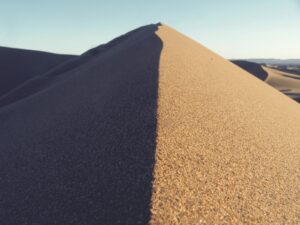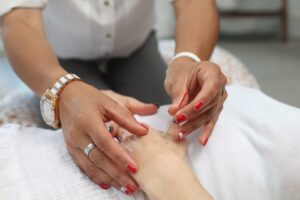Subscribe to the Newsletter
If you are interested in understanding how Traditional Chinese Medicine can improve your life sign up to my newsletter for the latest updates.

Well, obviously, I think they exist.
(What? – OK. Apparently that’s not enough.)
Did you know that a bunch of scientists think they’ve discovered proof? Actual, see-it-through-the-bottom-of-your-beer-mug proof?
An electron spectroscopy journal has published research done using CT (computerised tomography) scans. This shows that, compared to non-acupuncture points, real acupuncture points :
There! I KNEW you’d be interested!
What does it mean?
‘At the acupuncture points, micro-vascular densities with bifurcations “can be clearly seen around thick blood vessels” but non-acupuncture point areas showed few thick blood vessels and none showed fine, high density structures.
The acupuncture points contained fine structures with more large blood vessels that are several dozen micrometers in size plus beds of high density vascularization of vessels 15-50 micrometers in size.’
For more on this exciting topic, click here.
Source: Chenglin, Liu, Wang Xiaohu, Xu Hua, Liu Fang, Dang Ruishan, Zhang Dongming, Zhang Xinyi, Xie Honglan, and Xiao Tiqiao. “X-ray phase-contrast CT imaging of the acupoints based on synchrotron radiation.” Journal of Electron Spectroscopy and Related Phenomena (2013)
Yes, there’s more. Another bunch of scientists “used an amperometric oxygen microsensor to detect partial oxygen pressure variations at different locations on the anterior aspect of the wrist. The researchers concluded that partial oxygen pressure is significantly higher at acupuncture points.”
(No, I did electrical engineering at university, and I don’t know what it means either.)
However, they show pictures of the outcome, with clear shiny results for the acupuncture point locations. See the image below:

Reference: Minyoung Hong, Sarah S. Park, Yejin Ha, et al., “Heterogeneity of Skin Surface Oxygen Level of Wrist in Relation to Acupuncture Point,” Evidence-Based Complementary and Alternative Medicine, vol. 2012, Article ID 106762, 7 pages, 2012. doi:10.1155/2012/10a6762
In the image above you can see that each of the yellow or red areas seems to be occupied by an acupuncture point. On the left, under the thumb, you see Lung points Lung 8 and Lung 9. In the middle are Pericardium 6 and 7. On the right, under the little finger, are Heart points 4, 5, 6 and Heart 7.
There are lots of references to other work proving the existence of acupuncture points using
For the full article and references, click here.
So, after that brief introduction, click here for something lighter.
Or make yourself some green tea, take something for the headache you will shortly get, and settle down with the following.
When a needle is inserted it produces different kinds of reactions: some provide measurable biological acupuncture point evidence and we can measure these reactions which include:
This deals with how pain transmits to the brain along the spinal cord and how acupuncture uses another non-pain pathway that causes release of the body’s own painkillers – endorphins. The latter overcome the former.
This theory proposes that acupuncture points are leftovers from the very early growth control system in the embryo. As we grow, connections remain even when the physical locations of points are far apart. So there are points on the lower leg that continue to relate to points on the lower arm. Treating the former can relieve pain in the latter.
Some still believe that acupuncture is purely placebo in effect.
This has been disproved many times (Vincent 1986; Pomerantz 1976; Chan, 1975; Chen, 1980). One study found acute pain reduction by acupuncture analgesia was blocked by naloxon which stops the body’s natural opiates from working.
This suggests that acupuncture does stimulate those opiates, reducing pain.
This led to the neuro-humeral theory. This proposes that acupuncture stimulates production of endorphins, enkephalins and dynorphins, plus serotonin and noradrenalin in the synapses. (Cabyoglu, 2006)
Some studies show acupuncture inhibits the sympathetic nervous system and promotes the parasympathetic nervous system (Nishijo, 1997; Sugiyama, 1995; Sakai, 2007).
Ma, 2005, showed that electro-acupuncture at Zusanli, Stomach 36, on rats, increased production of Nitric Oxide, thereby lowering sympathetic activity in the body and as a result, lowered blood pressure. Another piece of research by Chen 2006 backed this up.
These show that stimulating certain acupuncture points produces reactions in the brain where it controls functions that acupuncture theory associates with the channels on which the points lie.
For example laser treatment at Bladder 67 stimulated activity in the visual area of the brain (Siedentopf, 2002). At Gallbladder 34 it increased activity in the motor area, again as predicted by theory (Wu 2002).
Niboyet 1961 and Backer 1976 showed that in healthy people acupuncture points have a lower electrical resistance compared with the surrounding skin. They found that the distribution of these lower resistance points was exactly where the ancient Chinese had put them.
These include postsynaptic inhibition (Stux, 2000).
Source for the above, with references, is an article in Journal of the Association of Traditional Chinese Medicine (UK) Volume 17 Issue No 2 (Sept 2010) titled “Science-based Mechanisms to Explain the Action of Acupuncture” by Man-Chi Wong Hui Jun Shen.
The last time I read up on this those in most favour were the morpho-genetic, neuro-humeral and local mechanistic theories.
Reading this kind of research on acupuncture point evidence gives me a headache so I can’t honestly say I do it much. Although I’m interested in the outcomes I work on another theory – based on results from what I do as inspired by knowledge and experience.

Stay in Touch!
No spam, only notifications about new articles and updates.

Book a Video consultation if you want to know more about your symptoms

This Introductory Chinese medicine course introduces you to the amazing thinking behind this ancient medicine, now increasingly in demand.

The Scottish College for Chinese medicine provides introductory courses for all, explaining Chinese medicine and its cultural background.

Master Tung’s acupuncture is a hidden treasure, lost to China but recovered in Taiwan from where it spread round the world.

Skin health comes mainly from good nutrition, good sleep and a happy outlook.
Subscribe to the Newsletter
If you are interested in understanding how Traditional Chinese Medicine can improve your life sign up to my newsletter for the latest updates.
Subscribe to the Newsletter
If you are interested in understanding how Traditional Chinese Medicine can improve your life sign up to my newsletter for the latest updates.